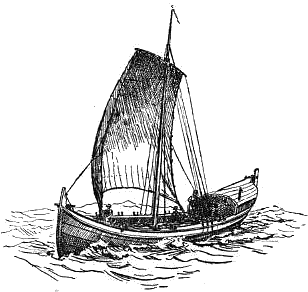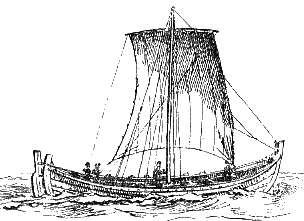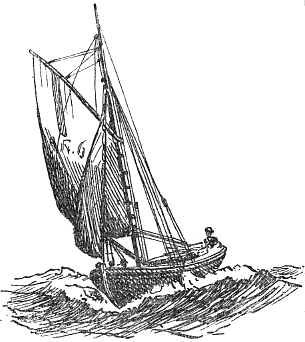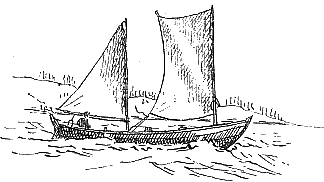NORDLAND COD-BOAT
 The
secret of the Nordland boat probably lies in the extreme
lightness of the ends, which makes her lively in a
sea-way, and in her handiness under oars; for, shallow as
she is, and narrow in the beam, she has none of the
qualities of a steady-going sea-boat. Her life in bad
weather depends upon the handling she receives. The most
feminine of boats, she demands a real man for her
helmsman, who knows his own mind and has a strong hand to
effect his purpose. Capricious, quick, seemingly, to
betray her charge, she yet loves to be ruled strongly. It
is only this she wants; and once she finds that she has
her master, she will take him through the wildest winter
night in safety, yet not without throwing more water than
is either seemly or safe. The
secret of the Nordland boat probably lies in the extreme
lightness of the ends, which makes her lively in a
sea-way, and in her handiness under oars; for, shallow as
she is, and narrow in the beam, she has none of the
qualities of a steady-going sea-boat. Her life in bad
weather depends upon the handling she receives. The most
feminine of boats, she demands a real man for her
helmsman, who knows his own mind and has a strong hand to
effect his purpose. Capricious, quick, seemingly, to
betray her charge, she yet loves to be ruled strongly. It
is only this she wants; and once she finds that she has
her master, she will take him through the wildest winter
night in safety, yet not without throwing more water than
is either seemly or safe.
STRILEBAAD
The characteristics of build are
shown quickest by a drawing. The planks are stout, few,
and wide. The width is often as much as 16 inches in some
parts; the ordinary five-oar herring-boat has only five
to her side, and the smaller boats but three.
OPEN FIVE-OAR HERRING-BOAT
 The
ends have great sheer, the sides great flare,
necessitating in many cases a waterway inclined sharply
in-board and carried from the quarters to each bow, upon
which the wooden oar tholes are usually fixed. A
wash-strake is fitted to some of the herring-boats when
deeply laden with nets or fish. In the larger boats used
for winter fishing, a small cabin is arranged aft by
building a bulk-head across at the quarters, raising the
gunwale and decking in to the stern. The
ends have great sheer, the sides great flare,
necessitating in many cases a waterway inclined sharply
in-board and carried from the quarters to each bow, upon
which the wooden oar tholes are usually fixed. A
wash-strake is fitted to some of the herring-boats when
deeply laden with nets or fish. In the larger boats used
for winter fishing, a small cabin is arranged aft by
building a bulk-head across at the quarters, raising the
gunwale and decking in to the stern.
NORDLAND BOAT, DEEP LADEN
Here a stove and bunks are
fitted, and some protection from the weather is obtained.
All these boats rely chiefly on oars for progress to
windward, having very little grip for weatherly work.
They carry a crew varying from three to ten men, and
range from quite small boats to 50 or 60 feet in length.
*1*
*1* A herring-boat 33 feet 6 inches in length has the
following dimensions:
- Beam, 8 feet 8 inches ;
- Depth, 2 feet 8 inches,
- Mast, 23 feet 3 inches;
- Yard, 11 feet, with from four to ten oars.
They are fast reaching, running or
pulling; but for beating are to all intents and purposes
mere rowing boats fitted with mast and sail, and are
generally obliged to wear instead of tacking.
SONDFJORD YAWL
The types vary slightly on
different parts of the coast. The Sondfjord boat on the
west coast, for instance, is almost similar to the
five-oar herring-boat depicted, but has more rounded stem
and stern, lighter ends, and is a deeper and therefore
better sea boat.
ARENDAL YAWL
The Sondmoersk boat is another
peculiar variety, with heavy ornamental stem and stern
posts, and very peculiar construction of timbering. She
carries her mast stepped amidships like the others, but
is rigged with a short yarded and peculiarly cut lugsail.
Around Arendal another class of lugsail boat is used,
very like the Shetland boats, and generally known to
British sailors as the Norway yawl.
Most of these boats have the long
tiller and yoke which is necessitated by the high
stern-post generally adopted.
SONDMOERSK BOAT
The ancient Norsemen got round
this difficulty by hanging the rudder upon the starboard
(stjornbordi) quarter, a system which was generally
followed until very modern times, and is still in use
extensively in the East.
As already hinted, the rig is very
simple, and consists of a single pole-mast stepped nearly
midships, on which is set an ordinary square sail. Like
her lineal descendants the 'keel' of our own east country
waterways, the Nordland boat carries a small topsail, and
the proportions of this sail in the two craft are very
similar. By means of bowlines carried to the stem head a
very flat set to windward can be obtained Two rows of
reefs along the head, and one along the foot, are the
rule. A stout forestay runs to the high stem-head, and is
fitted with a purchase for hoisting the mast up with, and
shrouds and backstay runner are used in the ordinary way.
The main halyard leads through a sheave below the
masthead, and is led down aft to a powerful purchase. The
old-fashioned and very effective rib and truck parrell is
used to keep the yard to the mast. It is the most
efficient form of parrell known to square-rig sailors,
and never jams.
The old Nordland jaegt which formerly
did so much of the coastwise trade of Norway was rigged
in a precisely similar manner. Owing to the comparatively
large tonnage of the vessel her gear was proportionately
heavier. The pole-mast was a very heavy spar, supported
by four shrouds on each side, and by topmast stays,
backstays, and a stout forestay and fore topmast stay.
The sail was reefed by means of bonnets along the foot,
four or five deep, so that close reefed it formed a handy
little sail. The main halyard had a very powerful
purchase which led down to the fore part of the high
poop, much as in the Arab bagala of the Indian Ocean. A
fore staysail was occasionally used. The most
characteristic feature about these high-sailed,
broad-beamed old vessels was the stern, which is quite a
reminiscence of two centuries ago, and may still be seen
in many of the trading-sloops and other small
fore-and-afters of the Baltic.
Coming to the southern coasts of
Norway, the most characteristic type is the old
Hvalor-baad, which is very closely related to the Swedish
and Danish Baltic craft, and from which has been
developed the modern pilot-boat and the sailing lifeboat
(Redningskoite).
OLD HVALOR PILOT-BOAT
• • •
NEW HVALOR BOAT
The hvalor-baad is the most
masculine of boats, and in every way is the direct
opposite of his Nordland sister. Bluff, broad, strong,
and deep, he will face any weather; he has no good looks
to boast of, but is singularly quiet and steady at times
when his sister of the north would be cutting capers and
looking for the nearest port to leeward. While she is
being coaxed and compelled to behave herself by six or
seven strong men, the hvalor boat will be standing out to
sea with one hand in the tiny cockpit, or having put his
pilots into inward-bound ships, will find his way home a
hundred miles or more all alone, except for the boy, who
appears to be carried rather for sake of company and out
of respect for the prejudices of sailor men than for any
help he can really give the hvalor boat in getting
home.
TRONDHJEM LIFEBOAT
In common with some of the broad
Danish and Swedish craft, this boat has remarkable
characteristics. Owing to the great beam, the motion in a
seaway is most peculiar; there is a sort of 'I'm not
going to be put out or knocked about, or splashed' sort
of way of going through a sea, which would reassure the
most timid landsman. Easy to handle, quick and light to
steer, sure in stays, snug and stiff in a squall, and
very fast, this kind of boat is the most comfortable for
cruising purposes that I have ever worked.
As will be observed, the rig is very
simple, and consists of a stout pole-mast stepped well
back in the boat; the somewhat ugly, square-cut Norse
spritsail, with peak lower than the throat for mainsail,
and a stay foresail, the sheets of both generally
travelling on horses.
PILOT
 There
is next to no rigging, a single stay on each side with
the forestay being all at is required. The mainsail has a
rope lacing to the mast, and is set up by hauling out to
the spreet end. A three-corner topsail set on a long yard
which stands up and down the mast, and a jib set on a
running bowsprit, complete the fine-weather
outfit. There
is next to no rigging, a single stay on each side with
the forestay being all at is required. The mainsail has a
rope lacing to the mast, and is set up by hauling out to
the spreet end. A three-corner topsail set on a long yard
which stands up and down the mast, and a jib set on a
running bowsprit, complete the fine-weather
outfit.
The hvalor boat does not pose as one
of the aristocracy of the sea, but he is one of the
sturdy upper classes who do good work in life. No boat
has more truly the instincts of the gentleman of good old
family, and one can imagine with what satisfaction the
old hvalor boats which are still left snub their anchor
chains, and chuckle to the ripples lapping about their
sides, when they see their big-bodied, handsome-looking
offspring, the modern lodsbaad, passing in or out to
sea.
SNAEKEE OR SKIFF, CHRISTIANIA FJORD
The lodsbaad or pilot-boat now
built is an improved hvalor-baad. It is an interesting
and significant fact that the improvements which have
been effected in the lines of these boats, and in their
speed and weatherliness, are largely due to a countryman
of our own, Mr. Colin Archer, who has long been settled
at the little port of Larvik, and who has made an undying
name for himself as the designer of Nansen's ship the
Fram. Norwegian fishermen owe him a great debt for the
manner in which he has devoted himself to the improvement
of these classes of vessel.
Following the law of development which
is rendered almost universal among types of sailing-boats
by the ever-increasing demand for speed and for greater
seakeeping capacity, the pilot-boats have increased
steadily in size. This, as in the case of the larger
Danish boats of the same sort, has necessitated the
substitution of the gaff and boom mainsail in place of
the old spritsail, the spreet in vessels of such tonnage
being a heavy unhandy spar in a rolling sea, involving
serious danger in case of the heel becoming unshipped
from the grommet.
OFF CHRISTIANSAND
Main and foresail are the sails
usually carried, the jib and topsail being fine-weather
adjuncts. The boats carry outside ballast, and are always
fully decked. Owing to their roominess they are very
comfortable below, and in them their crews can literally
face any weather that blows, even in the terrible
Skagerak.
Redningskoite
*1*
In 1892 a society was formed for
saving the lives of shipwrecked mariners. This society
has found a wide field for its operations principally
among the fishermen on the north and west coasts of
Norway, who collect in large numbers during the great cod
and herring fisheries, which, as already explained, take
place largely in the middle of winter, and in open
boats.
The lines given in the accompanying
diagrams represent the type of boat which has been found
most suitable as a life-saving boat among these
fishermen, being remarkably handy, able to stay out at
sea in any kind of weather, and powerful for towing
smaller boats to shore when caught in a gale off the
land.
The society has now built over fifteen
of these Skoiter, and there is a constant call among the
fishing population for more of them. A Redningskoite is
very strongly built. The stem and stern post, outer
planking, rudder head, stanchions, combings, and other
principal parts are oak. The frames are double, built of
grown yellow pine, the floors running across the keel and
consisting of the stem and root of the tree. Between each
frame is fitted a steamed and bent oak rib which is
riveted to the outer planking. They are carvel built. The
fastenings of the outer plank to the frames are wooden
treenails (juniper) and galvanised iron spikes above
water, metal spikes under waterline. Decks 2-inch pine.
Inside the frames is worked a water-tight lining from
gunwale to the cabin deck, which is likewise watertight
and firmly fixed, so that if the outer skin is stove the
boat will float on the lining. There are four watertight
bulkheads. The cockpit or helmsman's compartment has
water-tight floor and sides, and is sometimes furnished
with self-clearing pipes leading out-board. The crew
consists of four hands.
*1* For the description and lines of these boats I am
indebted to Mr. Colin Archer.
The sail plan explains itself. It is
designed for strength and handiness. The strongest canvas
and best rope and blocks are used. This is of the
greatest importance. No instance has occurred of these
boats being forced to seek shelter from stress of
weather, although they frequently stay out in heavy gales
all night and in the middle of winter. The chief danger
seems to be the giving way of some part of the gear.
*1*
It will be noticed that these boats
retain the characteristic shape of the old hvalor boat,
but that, in common with so many growing types of the
present day, they have, with their increase in size,
taken to the handy ketch or dandy or smack rig, as our
fishermen variously call it; they have become carvel
built; and like the lodsbaad they have adopted the modern
speed-giving device of outside ballasts.
*1* The iron keel weighs about 6 tons, and is fastened
with 12-14 galvanised iron bolts 14 inch, set up with
washers on the keelson. The boat carries about the
same weight of iron ballast inside, stowed under the
cabin floor. Displacement about 26
tons.
In 1894 I built a half-decked 22-foot
boat in Siam, very much, oddly enough, after the lines of
the modern redningskoite. In this little craft I
travelled long distances in the Gulf of Siam, and I can
vouch for the splendid sea-going qualities of such a
boat.
It will be noticed that although the
ends are well raked, there is no excessive cutaway, and
the large proportion of straight heel enables the boat to
lie well to the wind and run a steady course, both
important points in a sea-going vessel.
Of the larger boats it remains to
mention the Bankfiskerskoite. A deck fishing-boat so
named has long been used for open-sea fishing off the
west coast of Norway. The design sent me by Mr Colin
Archer is only one of many models used, each builder
having his own style. Several boats have, however, been
built of the kind here represented, some of them being
considerably smaller, for the Lofoten fisheries, but very
much on the same lines, and they have given great
satisfaction for seaworthiness, handiness, and good
sailing qualities. During the last year or two an
evolution towards steam has been going on, and here,
probably, as elsewhere, steam power for bank or open-sea
fishing will soon be extensively used.
BREVIK SKIFF
The drawing of the
Bankfiskerskoite shows a metal (cast-iron) keel. In
fishing-boats this is quite a modern innovation which has
not generally been adopted. In pilot-boats it is more
common. In a boat of the size represented the cast-iron
keel will weigh about 2+ tons, or about one-third of the
total ballast. The displacement will be about 17.5 tons.
But in these days of keen competition, and of
long-distance deep-sea fishing, Norwegian fishermen begin
to find they can afford to neglect speed as little as
Scotch or English fishermen.
The Seilsjegte *1* is a style of boat
used by the fishermen on the south part of the coast.
They are open boats with a washboard, and range from 18
to 25 feet in length, 20 feet being the ordinary
size.
They are clinker-built, like the
Norland boats, sail very well on all points, and are good
sea-boats, although like all open boats they require
careful handling. For the herring fisheries a somewhat
larger boat of a similar type is used. They all carry a
three-cornered topsail in addition to the usual fore and
mainsails.
*1* Termed snaekke; probably the Norse snekkja, a
'small longship' mentioned in
the sagas.
In the neighbourhood of Brevik and
Larvik one may see lots of these boats out fishing on
fine evenings, for every one living by the waterside,
whatever his occupation, owns a boat. Occasionally other
rigs are seen, like the one depicted. In Christiania
fjord the pleasure-boats are mostly of this type, though
some charming modern decked yachts are now in fashion.
Clinker-built with three to five wide planks, and wooden
treenails, sharp raking stern, and high bow, is the usual
type.

OFF BREVIK
|

 The
secret of the Nordland boat probably lies in the extreme
lightness of the ends, which makes her lively in a
sea-way, and in her handiness under oars; for, shallow as
she is, and narrow in the beam, she has none of the
qualities of a steady-going sea-boat. Her life in bad
weather depends upon the handling she receives. The most
feminine of boats, she demands a real man for her
helmsman, who knows his own mind and has a strong hand to
effect his purpose. Capricious, quick, seemingly, to
betray her charge, she yet loves to be ruled strongly. It
is only this she wants; and once she finds that she has
her master, she will take him through the wildest winter
night in safety, yet not without throwing more water than
is either seemly or safe.
The
secret of the Nordland boat probably lies in the extreme
lightness of the ends, which makes her lively in a
sea-way, and in her handiness under oars; for, shallow as
she is, and narrow in the beam, she has none of the
qualities of a steady-going sea-boat. Her life in bad
weather depends upon the handling she receives. The most
feminine of boats, she demands a real man for her
helmsman, who knows his own mind and has a strong hand to
effect his purpose. Capricious, quick, seemingly, to
betray her charge, she yet loves to be ruled strongly. It
is only this she wants; and once she finds that she has
her master, she will take him through the wildest winter
night in safety, yet not without throwing more water than
is either seemly or safe. The
ends have great sheer, the sides great flare,
necessitating in many cases a waterway inclined sharply
in-board and carried from the quarters to each bow, upon
which the wooden oar tholes are usually fixed. A
wash-strake is fitted to some of the herring-boats when
deeply laden with nets or fish. In the larger boats used
for winter fishing, a small cabin is arranged aft by
building a bulk-head across at the quarters, raising the
gunwale and decking in to the stern.
The
ends have great sheer, the sides great flare,
necessitating in many cases a waterway inclined sharply
in-board and carried from the quarters to each bow, upon
which the wooden oar tholes are usually fixed. A
wash-strake is fitted to some of the herring-boats when
deeply laden with nets or fish. In the larger boats used
for winter fishing, a small cabin is arranged aft by
building a bulk-head across at the quarters, raising the
gunwale and decking in to the stern. There
is next to no rigging, a single stay on each side with
the forestay being all at is required. The mainsail has a
rope lacing to the mast, and is set up by hauling out to
the spreet end. A three-corner topsail set on a long yard
which stands up and down the mast, and a jib set on a
running bowsprit, complete the fine-weather
outfit.
There
is next to no rigging, a single stay on each side with
the forestay being all at is required. The mainsail has a
rope lacing to the mast, and is set up by hauling out to
the spreet end. A three-corner topsail set on a long yard
which stands up and down the mast, and a jib set on a
running bowsprit, complete the fine-weather
outfit.